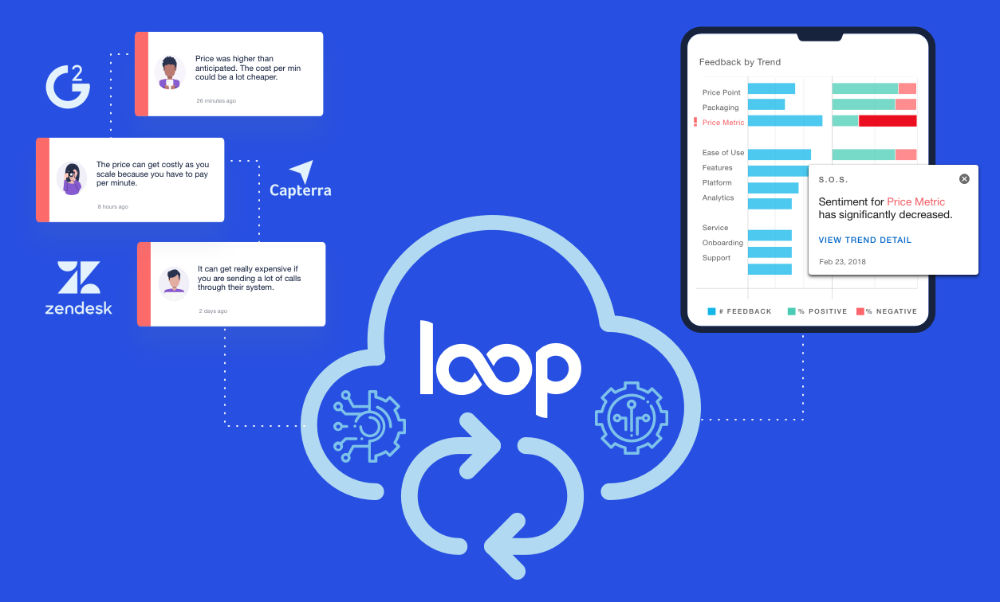Home » Quickstart Guide to Creating a Voice of the Customer Program
Quickstart Guide to Creating a Voice of the Customer Program

Lauren Culbertson
Co-Founder and CEO, LoopVOC

I started my first “Voice of the Customer program” with no budget and no resources.
I am using quotes because I didn’t set out to create something so formal, I just knew that listening to customers was essential for me to do my job well.
I was a Product Marketing Manager for a growing B2B SaaS product, and my Sales Manager and I were struggling with a bad decline in new customer revenue.
Our hypothesis was that we had gone slightly upmarket but were not providing enough value in our packages to warrant the premium price we were charging. We knew that collaboration across sales and marketing was essential to addressing the problem and charting a new path forward.
We did not have time to wait around for market research to prove this problem, so we started quantifying how often the issue came up in daily conversation. This strategy proved to not only be successful but also repeatable.
Why weren’t we prioritizing customer insights from frontline conversations every day?
You don’t need extensive resources to start building your Voice of Customer program. You just need to commit to listening deeply to customers, and you can get started today!
Here are the five ways we built a Voice of Customer program with no budget.
1.We leveraged frontline feedback
We started with our sales team, by tracking every time “lack of value” came up in sales calls, emails, and CRM notes. Technology and tools like Gong and Chorus make it even easier to gain insight from frontline conversations, but we started simple. We created a field in our CRM where sales reps could leave contextual notes about major issues impacting the deal. This helped us:
- better understand gaps in our value prop, positioning, and product
- quantify the revenue at stake due to the value gap
- segment which prospects are most impacted by the issue
Note: This requires you to trust your sales reps. If you can’t trust the people who are paid to represent the value of your company, you have bigger problems, and VoC will be a futile effort.
2. We reviewed conversations happening online
In addition to internal feedback, we tapped online channels of feedback like online reviews and forums. We read through community forums to better understand the top problems our market was discussing. We looked at our own online reviews to see how well we were solving those problems, and our competitors’ to see how we could solve customer needs in unique ways.
We looked at things like:
- Share of Voice: How did our volume of customer feedback compare to competitors? How recent was our customer feedback in comparison?
- Benchmarks: Were our customer feedback trends unique, or were competitors receiving similar feedback?
- Industry value: Where were users placing the most value in the collective feedback—product features, pricing, or customer support?
3. We read through verbatim NPS responses
Finally, we looked at the responses submitted via our NPS surveys to understand where our existing customers were frustrated. We paid special attention to those who were paying higher prices but were dissatisfied with the product. We followed up with those customers to understand where expectations fell short, propose new solutions, and further refine our hypotheses.
To get to the heart of your NPS survey feedback, we analyzed comments and categorized each comment into primary promoter benefit or detractor categories. This allows you to identify the larger themes across customer feedback so that you can focus on addressing the areas where customers are having the greatest issues.
4. We leveraged existing leadership meetings to share insights and close gaps
Once we had quantifiable intelligence across several unique stages of the customer journey, we brought our findings to discuss in existing weekly leadership meetings. Our goal was to align on:
- What problems was our market trying to solve?
- How well were we solving this problem for them?
- How well were our competitors solving this problem for them?
Once we were aligned on what our customers needed, and where we and our competitors fell short, we could focus our weekly meetings on translating those needs into HIGH VALUE action.
- Product Management built truly UNIQUE capabilities that warranted a premium price
- Product Marketing packaged and positioned those capabilities to maximize revenue
- Finance leveraged feedback KPIs like pipeline and NPS to model revenue impact
- Demand Generation created stronger messaging to drive excitement in the market
- Sales overcame price-objections by confidently positioning ROI
- Customer Success knew they could support customers to fulfill that ROI
5. We shifted to Customer-Led Growth strategies
That year our revenue grew by 20%, and VoC became part of our weekly discussion. What started as an experiment evolved into a proactive approach for exposing new issues as they started to emerge.
When you are thinking about how to get started with incorporating the Voice of the Customer into growth strategies, remember you can start small. When you adopt a mindset of Customer-Led Growth and it becomes easy to integrate customer needs into every area of your business.




